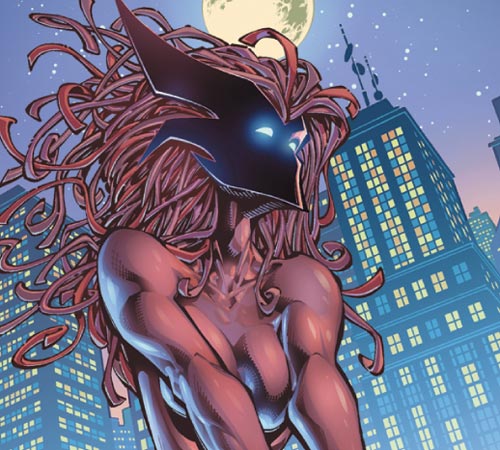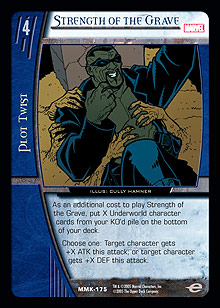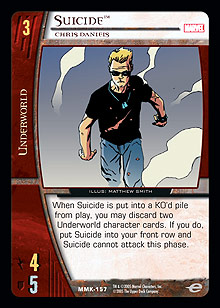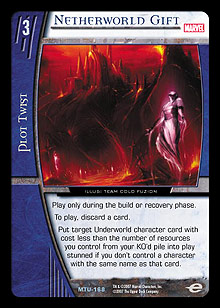Billy: We’re back again with another entry in the Marvel Team-Up design diaries. This week, as promised, we tackle those ethereal monsters of Pandemonium, the Underworld. If you didn’t read my preview article, here’s a brief fictional exchange to get you caught up:
Billy: So this was before my time, and pardon my rudeness, but it looks like you guys just pulled random dudes out of the Marvel Knights Encyclopedia and threw them on the Underworld team. That about cover it?
Andrew: (nodding his head fervently) No, of course not. We’re far more thorough than that.
B: Here’s a good one: Death Ninja? Oh, and there’s a guy named Stonecold. Apparently Blade had a crossover with the WWE.
A: Hey, smart guy, unless you can think of someone better—preferably vampire-related—Death Ninja is making his Vs. debut. Ding!
B: Okay, chill out, man. What if we do a cycle of Hell Lords at the high-drop points—a “Lords of the Underworld” kind of thing—and then we fill the lower points on the curve with lesser demons and human minions?
A: Why is it that every one of these “fabrications” alters reality to the point where it appears as though you came up with all the cool ideas on your own?
B: Egomania.
A: Whatever. Just give me a couple of cool “vampire lines” and try not to make any short jokes this week.*
Left Burning in the Lake of Fire
With our base theme established, we set out selecting noteworthy characters. In the preview article, I listed most of the demons that would be appearing in the set as character cards and threw in a couple of demons that appeared only on non-character cards or not at all. These last were characters like Belasco, D’Spayre, S’ym, Death, Surtur, Ymir, Loki, and Malekith the Accursed. Regrettably, I don’t think we’ll be seeing most of these for some time. Most of the Asgardian-themed guys really have no place outside of a team made up of Asgardians—except for Loki, who I hope we see very soon. Death fits in that odd cosmic entity category inhabited by such omnipotent beings as Eternity and the Living Tribunal. Look for her to appear as a plot twist long before she ever makes it onto a red card. Belasco, however, could easily make it into an X-Men set as Underworld legacy. So chin up, fanboys!
Fiery Art
The art, as most of you can see, breaks down into two major categories:
The Hell Lords were usually depicted in a hell dimension and sometimes, if it made sense, either sitting on a throne or standing in front of one.** The majority of the minion art placed the characters somewhere on Earth or thereabouts. The contrast in locations drew a link between the minion and his / her / its master or source of power. It didn’t always make sense to do this, but it turned out quite nicely when it did.
The best example of this would be Noble Kale and Black Rose:

In the art, we can see Noble Kale replacing Black Rose’s former master, Blackheart.
. . . and on a more humorous note, I give you Chthon and The Dwarf:
Judging by the expression on Chthon’s face, it’s hard to find good demon help these days. Fortunately for the exasperated Demon of the Darkhold, The Dwarf serves his master well.
It’s time now to kick it over to Andrew and Patrick for some relevant design notes.
Andrew: You know, I can’t help but feel that I’ve been shorting my end of the authorial responsibilities recently, but ever since my trip to Australia, I can’t get a wink of sleep. My adventures with drop bears have left me terrified, my eyes bloodshot, and my mood irritable. Really, they’ve left me with a complexion not unlike the very vampires and Underworld underlings that I will speak of this week.
 Days Past
Days Past
Historically, the Underworld was the very first team to thoroughly explore using the KO’d pile as a resource. The original Marvel Knights team was packed with cards that removed cards from your KO’d pile to pay costs, including Strength of the Grave and Dracula’s Castle. Combined with a slew of discard costs, the Underworld had a very coherent theme that arguably fell a little short on the tournament scene, at least when played alone.
Paired with the KO’d pile exploration was the use of concealed. As Marvel Knights was the inaugural set for concealed, the Underworld was in the right place at the right time and served as a perfect thematic fit for the mechanic. After all, who would be more apropos for a spankin’ new black frame than the children of the night themselves? As the mechanic itself was rather complex and subtle in its implications, we still saw glimpses of Underworld concealed flavor that helped differentiate them from the other teams. Cards like Shadow Step and Evil Awakens emphasized the idea of a transformation or rebirth through the use of concealed characters and movement between the hidden and visible areas.
The New World
Since Underworld is the only team making its return from Marvel Knights (the set I’ve frequently described as the spiritual father of Marvel Team-Up), it seemed only fitting that it maintain much of its original flavor. Since the main goal for the set was clean team definition, it would have been a shame to lose the original flavor by recreating the team from the ground up. With Underworld specifically, however, much of the remaining ground to which they could lay claim had already been usurped by the rascally designer Matt Hyra and his dark children, the Secret Society. Cards like Sorcerer’s Treasure and Straight to the Grave could easily have been Underworld cards, but they instead sat (happily) on another team. Therefore, a new theme was in order.
 It’s a well-kept secret, but one of my favorite cards from Marvel Knights was Suicide. Sure, the card itself may have been of questionable value, but it fulfilled so many design objectives at once:
It’s a well-kept secret, but one of my favorite cards from Marvel Knights was Suicide. Sure, the card itself may have been of questionable value, but it fulfilled so many design objectives at once:
- Make a cool power that is representative of the character and represents an ability that a player who may not be super-familiar with the team would expect.
- Link the power to the team’s overall theme (discard cards to fill the KO’d pile).
- Allow players to replace one sort of cost with another (in this case, KO costs and discard costs).
The last line has always been extremely significant for me; when searching for new design space, I often consider powers that enable players to circumvent costs by making other concessions (*cough* refer to the long list of banned cards that appear in Heralds of Galactus). While they frequently test the development limits of the game engine, the fact that they are dangerous makes them appealing to players.
With this inspiration, a new direction sprang forth: represent the undying nature of the Underworld entities through a variety of means. In the old Underworld, Suicide was a great example of this, but I wanted to take it in a slightly different direction.
One of the main differentiating features of Vs. compared to other card games is the durability of characters. It’s pretty rare to find a plot twist or any other card type that’s able to take down a character on its own, and even if it does, there’s a  chance that the character will just hang around and get recovered for the next turn. The recovery mechanic is often unexplored, but it is very much a defining feature of the game. To expand on this keyword, I decided to represent the undying nature of the Underworld characters using recovery effects, effects that keep stunned characters from becoming KO’d, and effects that pull characters back from the dead (KO’d pile) and put them into play in hibernation (Netherworld Gift). The idea of characters that basically couldn’t die was extremely attractive, especially when combined with effects that allow you to play characters without paying their recruit costs at all.
chance that the character will just hang around and get recovered for the next turn. The recovery mechanic is often unexplored, but it is very much a defining feature of the game. To expand on this keyword, I decided to represent the undying nature of the Underworld characters using recovery effects, effects that keep stunned characters from becoming KO’d, and effects that pull characters back from the dead (KO’d pile) and put them into play in hibernation (Netherworld Gift). The idea of characters that basically couldn’t die was extremely attractive, especially when combined with effects that allow you to play characters without paying their recruit costs at all.
Patrick: Of all the teams in Marvel Team-Up, I would say that Underworld was almost all Yip. For starters, the man loves some zombies, werewolves, and other such monsters, so the connection to the team was immediate. Furthermore, I think the attachment and mentality I had with Sinister Syndicate (“This team is so cool, if only a couple of things were done differently”), Yip also had for Underworld. This is not to say that the teams in the set got unequal attention, but it would be foolish to deny that we had our favorites going in.
Also interesting is that Underworld ended up very close to how Andrew initially envisioned them. They were obviously going to be a concealed team (in fact, the original mechanic was in part a flavor nod to Underworld), and the “leave my stunned guys around and recover them later” ended up being a very cool play pattern that we kept from start to finish. Underworld also highlighted an odd aspect of the set at first, which was that Marvel Team-Up had more concealed area hate then perhaps any other set we had ever done. The Marvel Defenders and Sinister Syndicate had a habit of killing nearly any deck composed of concealed characters very quickly, and Spider-Man had a lot of on-initiative exhaust effects that were particularly devastating for hidden decks. As such, certain cards (most notably Daredevil, New Kingpin) were changed to exhaust only visible characters, and I designed Electro, Shock Jock as both a powerful character and a card to make Syndicate slightly weaker against concealed strategies. I’m much happier now that the vampires and such actually get a chance to fight.
Looking at the final product, Underworld has a shocking amount of action. They have arguably the best team-stamped search card ever; arguably the best recovery card ever; one of our best 4-drops in Blackheart, Black King; and a couple of cards just waiting to be busted open. Of course, this is what happens when you let a zombie aficionado like Yip handle the Underworld re-feature.
Back to Billy: Join us the next two weeks as we wrap up the Design Diaries with the remaining Wild Pack and legacy content and a little bit of Q&A . . . speaking of which, please send any questions or comments about Marvel Team-Up design or flavor to Foilball@gmail.com. We’ll include as many of your questions as we can in the final article. It will probably be first come, first served, so start shooting those questions off as soon as possible. See ya’ then!
Selected Card Bibliography
- Blackheart, Black King: X-Force #74
- Doppelganger: Spider-Man Vol. 1 #26
- The Dwarf: Darkhold #1
- Madelyne Pryor, Goblyn Queen: X-Men: Inferno TPB
- N’astirh: X-Men: Inferno TPB
- Noble Kale, Lord of Hell: Ghost Rider Vol. 3 #92
- Queen Lilith, Den Mother: Ghost Rider Vol. 3 #28
- Thanos, Courting Death: Annihilation: Prologue
- Dark Designs: Defenders: Indefensible TPB
- The Dark Dimension: Defenders: Indefensible TPB
- Death’s Embrace: Spider-Man Vol. 1 #17
- Midnight Massacre: Nightstalkers #10
- Siege of Darkness: Nightstalkers #14
- Strange Love: Defenders: Indefensible TPB
- Surtur’s Anvil: The Mighty Thor #345
*Andrew Yip is short and he likes vampires.
**Can anyone say “chair deck”?